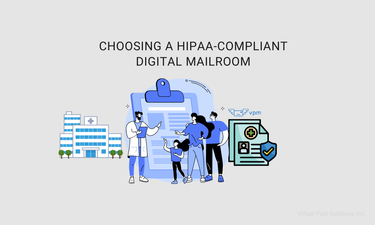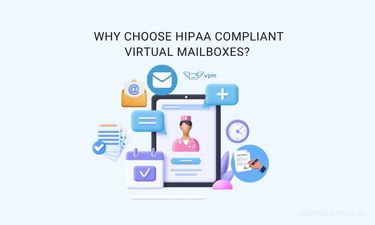Manual mail handling is inefficient and risky. Lost mail, unauthorized access, or scanning errors can lead to HIPAA violations and serious fines. According to the U.S. Department of Health and Human Services (HHS), the average HIPAA fine was over $450,000 per violation and from that source the most common compliance issues included:
- Unauthorized use/disclosure of PHI
- Insufficient safeguards
- Denial of patient access to PHI
- Weak administrative protections for electronic PHI
- Over-disclosure beyond "minimum necessary"
Key Pain Points in Healthcare Mail Handling
- Misdirected or mishandled mail is a major cause of HIPAA breaches (HHS Office for Civil Rights)
- Unauthorized access and lack of audit trails continue to challenge compliance (Ponemon Institute 2023 Report)
- Insurers and labs require street addresses over P.O. Boxes (Medicare Program Integrity Manual)
- Outsourcing mail increases breach risks (Protenus Breach Barometer)
- Manual routing causes delays and errors (Health IT Analytics)
Digital Mailroom Evaluation Checklist
1. HIPAA Compliance and Business Associate Agreement (BAA)
What to look for:
- Signed BAA
- Role-based access control
- AES-256 and TLS 1.2+ encryption
- Retention and destruction policies
Questions to ask:
- Can you share a redacted version of your BAA?
- What safeguards enforce the Minimum Necessary Standard?
- How frequently is staff trained?
2. SOC 2 Type II Certification
What to look for:
- SOC 2 Type II reports
- ISO 27001 certifications
- Regular audits
Questions to ask:
- How often are audits conducted?
- Can we see the latest report summary?
- Have any controls failed?
3. Physical Facility Security
What to look for:
- 24/7 surveillance
- Segregated healthcare mail
- In-house HIPAA-trained staff
Questions to ask:
- Are mail centers owned and operated internally?
- What physical controls are in place?
- How is PHI protected?
4. Data Lifecycle Protection
What to look for:
- AES-256 encryption at rest, TLS in transit
- U.S.-only data storage
- Shredding with audit logs
Questions to ask:
- Do you support automated retention policies?
- Can we integrate with our EHR?
- How do you handle unauthorized access?
5. Secure Remote Access
What to look for:
- Web-based portal with MFA
- Download restrictions and watermarking
- Role-based access
Questions to ask:
- Can downloads be restricted?
- Are access logs available?
- Do you support IP-based alerts?
6. Transparency and Compliance Documentation
What to look for:
- SOC 2, HIPAA, and audit process documents
- Breach response timelines
- Chain-of-custody logs
Questions to ask:
- What’s your breach notification timeline?
- Can we request a compliance walkthrough?
- Do you share audit documentation?
7. Business Continuity and Disaster Recovery
What to look for:
- Owned and operated mail centers
- Secure data backups
- Tested recovery plans
Questions to ask:
- What is your guaranteed uptime?
- How is data protected during outages?
- Can we see your disaster recovery documentation?
8. Chain of Custody and Tamper Prevention
What to look for:
- Timestamped handling logs
- In-house scanning and shredding
- Anomaly detection alerts
Questions to ask:
- How is custody tracked?
- What tools prevent tampering?
- Can we audit each document’s handling?
9. Multi-Department Routing
What to look for:
- Workflow logic by sender, department, or keyword
- Support for multi-location teams
Questions to ask:
- Can billing and clinical teams receive different mail types?
- Are routing rules customizable?
- Can the workflows scale?
10. Vendor Portability and Data Ownership
What to look for:
- Bulk document export with metadata
- No lock-in clauses
- API access
Questions to ask:
- How do we export data?
- What’s your off-boarding process?
- Can we control our own backups?
11. Security, Tracking, and Saving Time
What to look for:
- Shredding and recycling
- Courier reduction
- Mail volume tracking
Questions to ask:
- How do you recycle and shred securely?
- Do you track scans?
The solve? A HIPAA-compliant digital mailroom helps prevent these issues by:
- Automating the intake and scanning of physical documents
- Ensuring secure storage and access
- Centralizing mail distribution to authorized personnel
Scenario: Time and Cost Savings
Imagine: A behavioral health clinic receives 120 pieces of mail weekly. With in-house staff, it takes approximately 15 minutes per item to log, open, scan, and distribute sensitive documents securely—totaling 30 hours per week. With VirtualPostMail (VPM), the same mail is digitized and routed securely within 24 hours, saving the team over 100 staff hours per month.
Summary Checklist
| Requirement | Why It Matters | Questions to Ask |
|---|---|---|
| HIPAA Compliance & BAA | Protects legal use of PHI | BAA, access control, audit logs |
| SOC 2 Certification | Verifies data security practices | Audit frequency, control failures |
| Physical Security | Prevents physical data breaches | Facility access, custody logs |
| Data Lifecycle Protection | Controls access, storage, and shred | Retention, encryption, audit logs |
| Secure Remote Access | Enables remote compliance | MFA, restrictions, logs |
| Transparency | Builds trust with documentation | Incident timelines, audit access |
| Business Continuity | Ensures uptime and resilience | Uptime SLA, recovery procedures |
| Chain of Custody | Proves document integrity | Tamper detection, audit trails |
| Routing & Workflows | Improves efficiency | Custom routing, team logic |
| Vendor Portability | Ensures future flexibility | API access, export support |
| Sustainability | Reduces waste and overhead | Shredding, mail volume tracking |
Conclusion
Selecting a HIPAA-compliant digital mailroom is about more than secure scanning—it’s about aligning with your healthcare organization's compliance, operations, and patient care goals.
VirtualPostMail (VPM) delivers a purpose-built digital mailroom platform backed by HIPAA safeguards, SOC 2 Type II certification, and fully in-house mail handling. Save time, reduce costs, and digitize sensitive communications—without compromising privacy or control.







